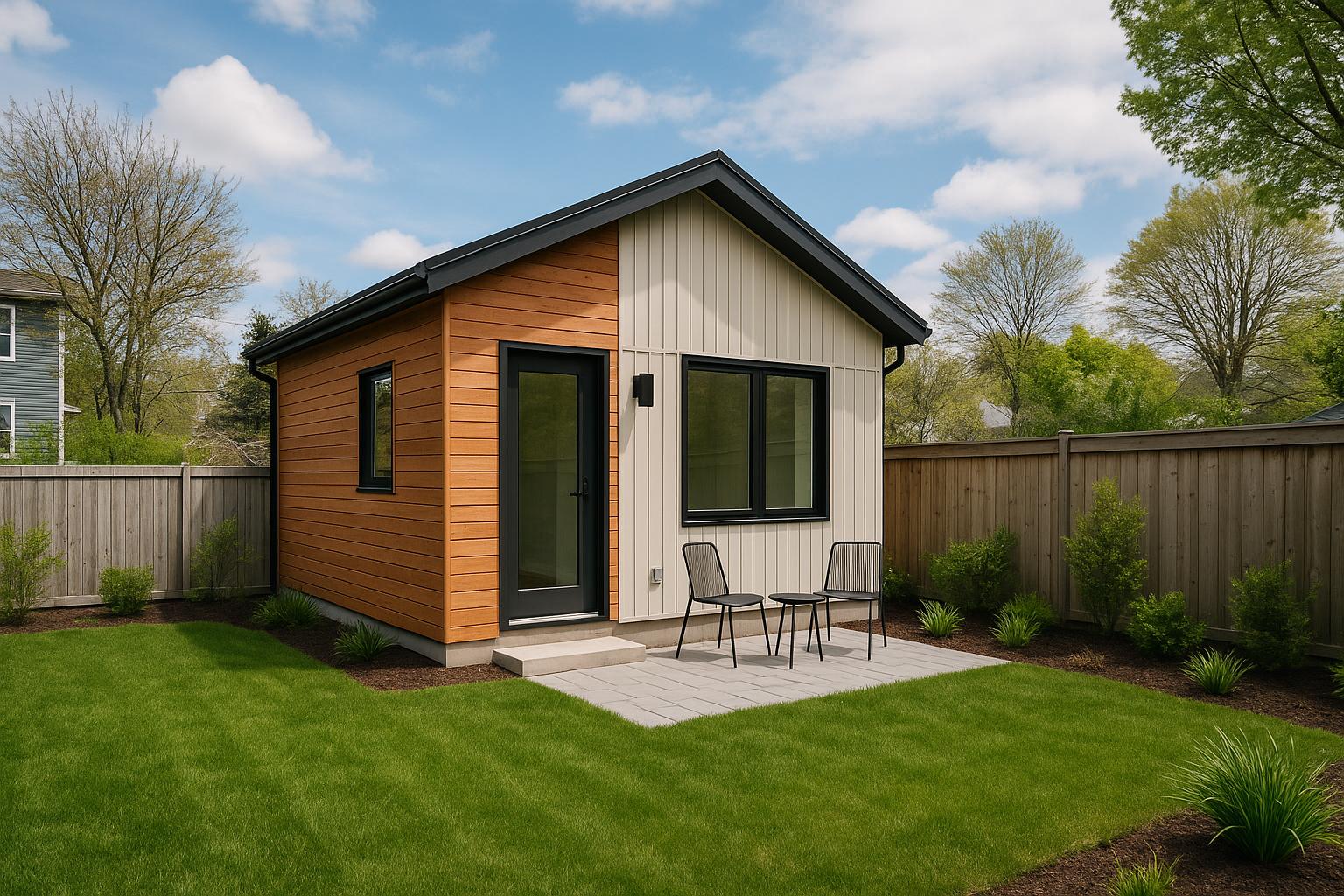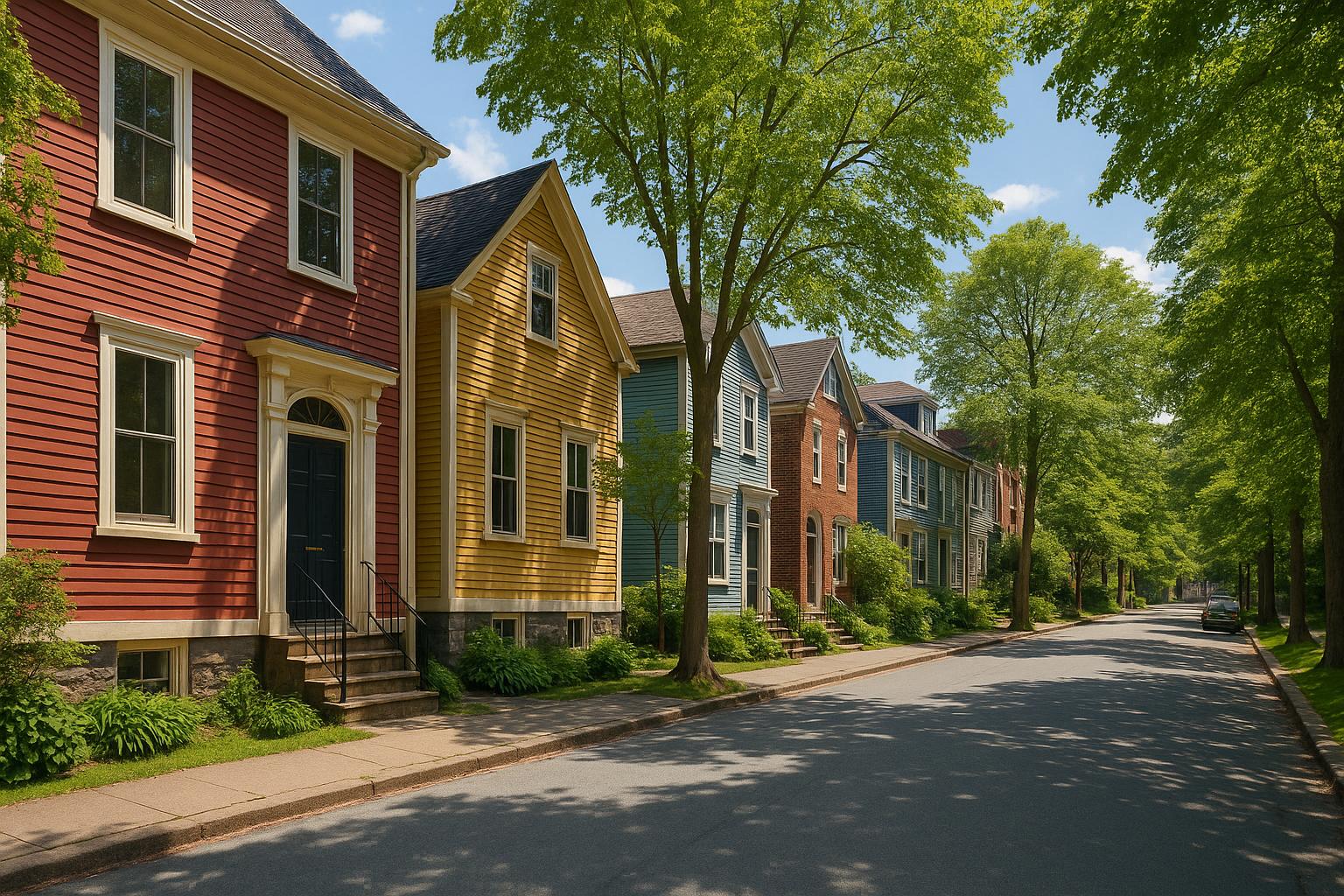Atlantic Canada’s coastal weather demands durable, wind-resistant roofing systems. Harsh storms, salty air, and heavy snow create challenges that standard roofs can’t handle. For property owners, investing in the right materials, installation techniques, and warranties is critical to protect their investment and reduce long-term costs.
Key Takeaways:
- Nailing Schedules: Proper fastener placement, especially on roof edges, ensures resistance to strong winds (up to 225 km/h).
- Underlayments: Synthetic and self-adhered membranes perform best in coastal climates, offering moisture protection and durability.
- Roofing Materials: Metal roofs, polymer-modified shingles, and synthetic slate are top choices for wind resistance and longevity.
- Warranties: Look for coverage that includes wind speed limits, salt corrosion, and transferability for added protection.
- Integrated Construction: A single-team approach ensures quality, avoids delays, and maximizes roof performance.
Atlantic Canada’s weather is tough, but with the right approach, your roof can withstand the elements while reducing maintenance and repair costs.
Severe Weather & Wind Resistant Roofing Materials - IKO's Multilayered Residential Roofing Systems
Nailing Schedules for Wind Resistance
Getting the nailing schedules right is crucial for ensuring roofs in Atlantic Canada can withstand strong winds. Proper fastener placement not only meets safety standards but also supports the roof's long-term durability.
Nailing Schedule Basics
The National Building Code of Canada (NBCC) lays out the minimum fastener requirements for roofing systems. Since 2015, the CSA A123.21 standard has been used to define wind uplift resistance benchmarks. This standard ensures that fasteners are chosen based on both the roofing material and the substrate, helping roofs resist wind forces effectively. These baseline requirements are particularly important in regions prone to extreme wind, as they form the foundation for more advanced strategies.
Wind Uplift Nailing Requirements
In Atlantic Canada, where extreme wind events are common, enhanced nailing strategies go beyond NBCC's baseline requirements. The NBCC uses a 1-in-50-year return period to calculate uplift pressures, reflecting the region's frequent exposure to severe winds [2]. Roof edges and corners face the highest risk, with wind pressures reaching up to three times those experienced in the roof's central areas [1]. To address this, additional fastening is often necessary along these vulnerable perimeters.
Calculating wind loads involves several factors, including the building's location, size, exposure to the elements, and risk category [3]. Adhering to proper installation protocols ensures that roofs can reliably handle these challenging conditions.
Underlayments for Coastal Weather Protection
In Atlantic Canada, where wind-driven rain and freeze-thaw cycles are the norm, choosing the right underlayment is crucial. The region's coastal climate demands materials that can endure harsh conditions while providing long-term durability.
Underlayment Material Types
Synthetic underlayments are a top choice for coastal environments. They offer up to twice the tear resistance of some competing synthetics and stand up well to heavy roof traffic [5]. With strong UV resistance, these underlayments can remain exposed for six to 12 months, though some products are limited to 90 days [5][6]. Their ability to repel moisture helps prevent fungal growth and wrinkling, making them particularly well-suited for the challenges of coastal weather.
Traditional felt underlayments, while still used in some scenarios, are less ideal for coastal conditions. They absorb moisture more readily and are vulnerable to UV damage, which means they need to be installed quickly to avoid deterioration.
Self-adhered membranes are a premium option, especially for critical roof areas. These underlayments combine waterproofing with elasticity, creating a highly effective barrier against water intrusion.
Each material has its place, but the unique demands of coastal construction often require careful consideration of their specific benefits and limitations.
Ice and Water Shield Installation
Ice and water shield underlayments use asphalt polymers to deliver waterproofing and elasticity [4]. The asphalt creates a complete moisture barrier, while the polymers add flexibility and stickiness, enabling the material to self-seal around fasteners. This self-sealing feature is particularly useful in areas prone to ice dams and freeze-thaw cycles, as it helps prevent water from seeping in [4]. To ensure full protection, installation must be precise, especially in vulnerable areas.
Underlayment Performance Comparison
| Feature | Synthetic | Felt | Self-Adhered |
|---|---|---|---|
| Tear Resistance | Up to 2x stronger than some synthetics [5] | Lower tear resistance | Excellent tear resistance |
| UV Exposure | 6–12 months exposure; some up to 90 days [5][6] | Limited UV tolerance | Not specified |
| Moisture Resistance | Repels moisture; resists fungal growth [6] | Prone to moisture absorption | Complete moisture barrier |
| Self-Sealing | None | None | Self-sealing around fasteners [4] |
Synthetic underlayments provide a well-rounded option for most applications, while self-adhered membranes excel in protecting critical areas like eaves, valleys, and roof penetrations.
When working in Atlantic Canada's coastal regions, extended exposure periods during construction are common due to weather delays. This makes UV resistance and overall material durability key considerations when selecting the right underlayment for the job.
Roofing Material Selection for High Winds
Choosing the right roofing materials is critical in areas prone to high winds and storms, especially along coastal regions. The goal is to find materials that combine wind resistance, durability, and long-term value. With frequent storms and harsh conditions, these materials must maintain their protective qualities for years. Building on the foundation of underlayment choices, selecting durable roofing materials is key to achieving full wind protection.
Best Roofing Materials for Windy Conditions
Metal roofing systems are a standout option when it comes to wind resistance. Standing seam metal roofs, which use concealed fasteners, are designed to perform exceptionally well under high winds. Their interlocking panels evenly distribute wind loads, boosting overall stability. Aluminum and steel panels also offer excellent corrosion resistance in salty, coastal air. With protective coatings to enhance longevity and the ability to shed ice and snow during freeze–thaw cycles, metal roofs are both practical and durable.
Polymer-modified asphalt shingles provide a budget-friendly alternative without compromising too much on performance. These shingles feature a laminated, multi-layer design and stronger adhesive bonds, making them more resistant to wind uplift compared to standard shingles. For homeowners looking for a cost-effective solution, these shingles strike a good balance between affordability and reliability.
Synthetic slate and composite materials offer a middle-ground option, blending visual appeal with dependable performance. These materials are lighter than natural slate, reducing the structural load on the building, and they’re engineered to resist moisture issues common in humid coastal climates. They combine aesthetics with functionality, making them a popular choice for coastal properties.
Installation Techniques to Enhance Wind Resistance
Even the best roofing materials need proper installation to perform well in high winds. Techniques like using concealed fasteners, interlocking systems, and reinforced edge securement can significantly boost wind resistance. Concealed fasteners reduce the risk of water intrusion by keeping nails or screws hidden, while interlocking systems create continuous seals along vulnerable edges, such as the roof’s perimeters.
Enhanced edge securement is especially important in critical areas like eaves, rakes, and ridge lines. Adding extra fasteners in these spots strengthens the connection between the roof and its deck, preventing uplift during strong winds. Additionally, careful attention to flashing around penetrations, valleys, and transitions is essential to stop water from seeping in after wind damage.
While wind resistance ratings are typically tested in controlled lab settings, actual performance can vary depending on installation quality, roof slope, building height, and the property’s exposure to the elements. For homes in highly exposed coastal areas, it’s wise to go beyond the minimum code requirements to ensure the roof holds up over time.
sbb-itb-16b8a48
Roofing Warranty Protection
Having the right warranty for your roofing system is essential, especially in Atlantic Canada, where coastal weather can be harsh. A solid warranty protects your roof from wind damage, salt corrosion, and other weather-related challenges common in these environments. Since warranties differ in their terms, it's crucial to read the fine print to ensure your roof is fully protected during severe storms. Here's a breakdown of warranty options and what they cover.
Warranty Types and Coverage
Manufacturer warranties focus on material defects, such as cracking, fading, or structural issues. For properties in Atlantic Canada, confirm that the warranty specifically addresses coastal conditions, including resistance to salt air and strong winds. This ensures your roof can withstand the unique challenges of the region.
Workmanship warranties safeguard against installation mistakes that might lead to problems like leaks or loose components. Reputable contractors often offer these warranties, aligning their coverage with the lifespan of the roofing materials they install.
System warranties provide more comprehensive protection by covering both the materials and the installation. This type of warranty simplifies the claims process, as it eliminates the need to determine whether an issue stems from defective materials or improper installation.
Important Warranty Terms
Certain terms are especially important for homes and buildings in coastal areas:
- Wind speed coverage: Coastal properties often experience high winds. Some warranties may exclude damage from winds above a specific speed, so it's wise to choose one that includes extended wind protection suitable for Atlantic Canada’s weather.
- Salt corrosion protection: Coastal air accelerates the wear and tear on roofing materials, particularly metal roofs. A warranty that includes protection against salt corrosion can save you from unexpected repair costs.
- Transferability: A transferable warranty can enhance the value of your property by allowing the new owner to benefit from the coverage. This feature can make your home more appealing to potential buyers.
Additionally, check whether the warranty is prorated or non-prorated. A non-prorated warranty provides consistent protection over time, while a prorated one reduces benefits as the roof ages. Be sure to review common exclusions, such as damage from ice dams, poor ventilation, structural shifts, or extreme weather events. Also, keep up with required maintenance and inspections, as failing to do so could void your warranty.
Warranty Coverage Comparison
| Warranty Type | Wind Speed Coverage | Duration | Salt Air Protection | Transferability | Cost Premium |
|---|---|---|---|---|---|
| Standard Manufacturer | Standard coverage | Multi-decade | Limited | Non-transferable | Included |
| Premium Manufacturer | Enhanced coverage | Extended protection | Included | Transferable | Slight additional cost |
| Workmanship Only | Varies with installer | Shorter term | N/A | Rarely transferable | Low premium |
| System Warranty | Enhanced coverage | Comprehensive coverage | Included | Transferable | Higher cost |
Investing in a well-rounded warranty can save you from costly repairs during severe weather. When comparing options, think beyond the upfront cost and consider the total cost of ownership. Make sure you fully understand the warranty terms and documentation requirements to avoid disputes when you need to make a claim. A strong warranty provides peace of mind and long-term value, especially in challenging coastal climates.
Integrated Construction for Roofing Success
In Atlantic Canada, the lifespan of a roof on multi-unit properties isn’t just about the materials used - it's about how well the construction process is managed. A coordinated, integrated construction approach ensures better wind resistance and durability, while fragmented management often leads to costly inefficiencies.
Problems with Fragmented Construction
When property owners rely on fragmented construction, they’re often left juggling multiple contractors and professionals. This can lead to budget overruns, delays, and even lost rental income. And when something goes wrong, the absence of a single point of accountability means property owners are stuck mediating disputes instead of focusing on their investment.
Why Integrated Design-Build Works
An integrated construction model solves these problems by bringing planners, architects, engineers, and construction crews together under one roof from the get-go. This approach guarantees single-point accountability, meaning one team is responsible for the performance of the entire roofing system.
With everyone on the same page, projects benefit from fixed-price contracts and synchronized schedules that eliminate delays. As one manufacturer puts it:
"Leading manufacturers understand the direct connection between installation quality and how well their roofing products perform long-term. To help homeowners get lasting value and provide peace of mind, they offer optional extended warranty coverage on new roofs installed by authorized contractors who are certified to install the roofing system according to the manufacturer's installation requirements." [7]
This kind of streamlined process ensures that the roofing system not only meets high standards but also provides long-term value.
The Helio Urban Development Edge

Helio Urban Development stands out as Nova Scotia’s only integrated design-build firm specializing in 4+ unit rental properties. Their approach guarantees a six-month timeline, with penalties for delays, and a fixed price per unit. They also provide triple quality verification, real-time photo updates, and a dedicated project portal, so property owners stay informed every step of the way.
Currently, Helio has 31 units under construction and 131 more in planning across Nova Scotia. Their integrated model transforms roofing projects into predictable, reliable processes - a major advantage in Atlantic Canada’s challenging coastal climate. By choosing Helio, property owners can rest assured their investment is protected.
Conclusion: Protecting Your Roofing Investment
In Atlantic Canada, ensuring your roof can withstand the elements requires more than just good materials - it demands precise installation and a thoughtful approach to construction. By combining proper nailing techniques, durable underlayments, and comprehensive warranties, you create a roofing system that protects your multi-unit property and maximizes its long-term value.
The numbers speak for themselves: from 2009 to 2022, Canada experienced 139 insurance catastrophe events, 80% of which involved wind damage [10]. For property owners in Nova Scotia, this highlights the serious financial risks posed by wind-related damage. Whether it’s rental income losses, increased maintenance costs, or a drop in property value, the impact is clear. Investing in wind-resistant roofing for new wood-frame houses in Canada offers an average benefit-cost ratio of 6:1 [10], making it one of the smartest choices for safeguarding your property.
However, even the highest-quality materials can't perform if they’re installed poorly. That’s why the construction method is just as important as the products used.
A well-planned construction approach ensures that every component - roof shape, pitch, underlayment, and reinforcements like hurricane straps - works together to maximise wind resistance and prevent water damage [9]. This coordinated system reduces the risk of installation errors that often lead to early roof failure.
For example, expert installation of metal roofing involves meticulous attention to detail, from cutting panels to sealing seams and managing gaps [8]. When done right, metal roofs can last 40 to 70 years, far outlasting asphalt roofs, which typically need replacing every 15 to 20 years [8].
Helio Urban Development exemplifies this integrated design-build approach, streamlining construction for multi-unit rentals in Nova Scotia. Their method ensures compliance with regulations while minimising coordination risks, delivering durable and efficient roofing systems [8][9][10].
FAQs
What are the main differences between synthetic underlayments and peel-and-stick membranes for roofing in coastal areas?
Peel-and-stick membranes are designed to create a watertight barrier, making them a smart pick for coastal regions that face high humidity, heavy rain, and strong winds. These membranes bond directly to the roof deck, providing top-notch defence against leaks and moisture.
Synthetic underlayments, while water-resistant, don’t offer the same level of waterproofing. They’re lightweight, durable, and work well in areas with gentler weather but might fall short in protecting against the intense conditions of coastal environments.
Given the tough weather in Atlantic Canada, peel-and-stick membranes are often the go-to solution to shield your property from powerful storms and constant moisture exposure.
How does an integrated construction approach enhance the durability and wind resistance of roofing systems in Atlantic Canada?
An integrated construction approach ensures that every part of a roofing system is designed and installed to function as a cohesive unit - crucial for standing up to the high winds and harsh weather often seen in Atlantic Canada. By carefully coordinating details like nailing schedules, sturdy underlayments, and proper sealing techniques, this method reduces weak points that could otherwise lead to roof damage or even failure.
Beyond durability, this approach simplifies the process by offering single accountability. With one team overseeing the entire project, there’s less chance of miscommunication or missed details between contractors. The result? A roofing system that's built to last, offering homeowners peace of mind and long-term protection for their investment.
What should property owners consider when choosing a roofing warranty for Atlantic Canada's challenging weather?
When choosing a roofing warranty, it's crucial to ensure it covers two key aspects: the quality of the contractor's installation and the longevity of the materials supplied by the manufacturer. Pay attention to warranties that specifically mention protection against harsh weather conditions like high winds and heavy rainfall, which are frequent in Atlantic Canada.
Additionally, take the time to understand the warranty's length, any coverage restrictions, and the maintenance tasks required to keep it valid. A well-rounded warranty not only protects your roof but also helps secure your investment for years to come.
Related Blog Posts
- Designing for Nova Scotia’s Climate: Storm-Resilient Homes from Roof to Foundation
- Built to Last: Top Durable Materials for Nova Scotia’s Coastal Climate
- Can You Build Through Winter in Nova Scotia? Methods, Sequencing, and Risk
- Coastal Site Construction in Nova Scotia: Materials That Survive Salt and Freeze‑Thaw



